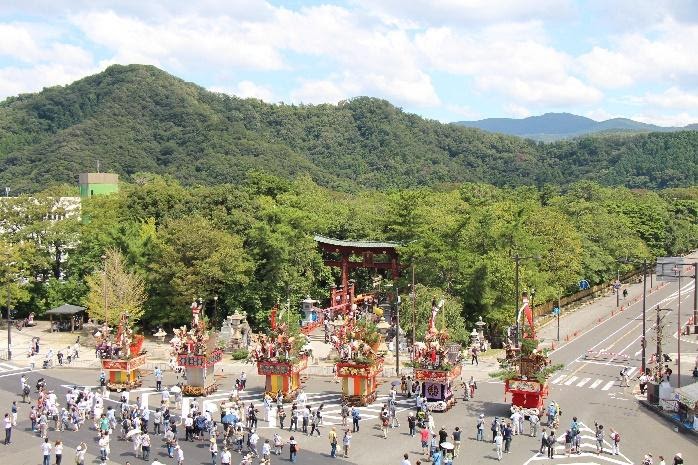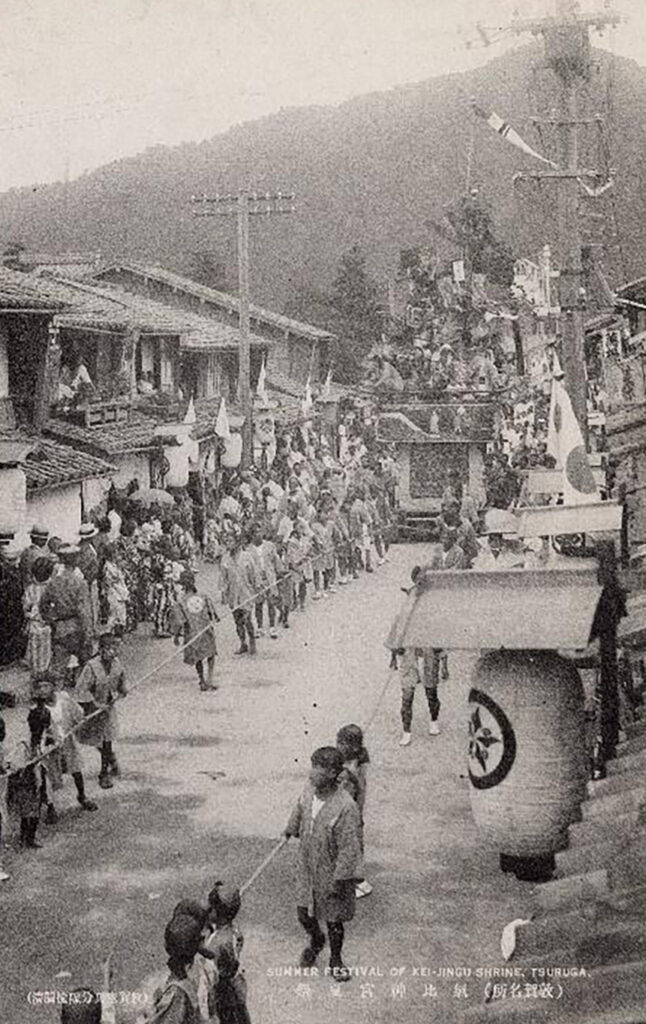The Origine of Yama

Yama Is Equipment for Palliating Illness And Disasters
Today the Yama float festivals are held all over Japan; the first festival kind of Yama was in Kyoto as Gion Goryokai (a Shinto ritual).
The festival of floats began with the attempt to send the ghosts out of the town. In the past, people trusted that all illnesses and disasters were caused by ghosts which have grudges in the living world. They flowed long halberds, tall trees, and ornaments-objects shaped of mountains-into rivers and the sea or destroyed them, believing the ghosts lean on them.
Yama floats of Tsuruga and Kyoto have common features: standing pine trees as a substitute for the gods and decorations shaped mountains: it points Tsuruga Yama floats have been influenced by Kyoto since the past.
The origin of the Tsuruga Yama floats is not clear, but they have existed at least at the end of the Muromachi period (1136-1573). The documents that remain in Tsuruga describes that Oda Nobunaga visited Tsuruga and saw the Yama in 1575. Although the contents of the writings perhaps just hearsay, the Tsuruga Yama floats possibly have been seen at least at that time.
History of Yama

Tsuruga Yama Floats people present their financial powers and merchant spirits with the development of Tsuruga port. At the climax maximum of 30 to 50 Yama was moved around the city in around 1800-1829.
-Edo period-
Yama has used for float parade in the ritual festival of the Kehi Jingu shrine; the pre-festival is held on August 2nd, the main festival is held on 3rd and 4th. There are 36 towns in Tsuruga at that time, 12 towns of them have divided into east and west and joined the Yama parade every other year; there are two types of Yama: Oyama moved by town and Koyama moved by the individual.
Oyama is so large that it fills the width on narrow roads, breaks the eaves, and is difficult to turn the corner. pine trees standing on the Yama are made of large trees: at least a height of 9 m or more and a trunk circumference of 90 cm or more. Despite the large size, the decoration of Oyama was not as luxurious as Koyama.
About 4 to 5 Koyama floats took from each town, a total of 40 to 50 floats were moved around the town at the most; its spectacular appearance can be imagined. The size of Koyama is smaller than that of Oyama, but it has luxurious decorations: Genuine armors, harnesses, costumes with gold and brocade, curtains with Ezo and Karanishiki, gold and silver columns, and beautifully embroidered ornaments. The theme of decorated scenes was often chosen from Chinese events and battles. In the past, doll-decorations were not only samurai dolls but also other themes.
Decorations of Yama had become so greater year by year that the Obama domain issued an order to limit the height and the number of floats and prohibit the use of gold and silver foil and swords for the floats, concerning about increasing luxury of Yama.
-Meiji era-
In the Meiji era, the Yama float event changed drastically due to the influence of the Meiji Restoration. During the era, while the number of floats and towns managing floats was changed many times, with changing town-names and divisions, the recession, and large fires, the system of Yama parade has been maintained.
In 1873, Oyama (larger float) parade on Aug. 4th was abolished, Koyama (smaller floats) that was put out by individuals and local unions would be pulled out on the day. The number of floats was decided to be one per town, and 12 towns now release 12 floats every year.
The festival day has also changed because of the introduction of the solar calendar in Japan. After 1875, the festival day changed to September 3rd to 4th: one month later than before; it is still held on this date today.
On the 3rd, when the floats are no longer cruising, the mikoshi (portable shrine) of Kehi Shrine will be handed over from later years, and the mikoshi will be sent out from towns other than the float town to regain the bustle.
-Around WWII and today’s Yama-
Disorder from the Great Depression and World War II had the Yamma festival to decline, but they have gradually revived after WWII and continue to this day.
In the 1920s due to the Great Depression that began from Wall Street, Tsuruga also fell into a serious recession and the Yama festival was difficult financially.
When the Sino-Japanese War began in 1937, the system of the festival was changed: there are only displayed Yama but they did not move around, and in 1943, furthermore the display was also canceled.
In 1945 during World War II, a bomb attacked Tsuruga City, and about 80% of the city area was damaged. Many of the floats were also burnt away, only three Yama had remained.
For a while after the war, the Yama festival was not held, but local people have desired to revive the Yama festival. In 1982, the Yama festival which three of Yama joined to was carried out for the first time after the war; people wished to reconstruct more Yama. The “Tsuruga Float Preservation Society” (since 1979) made efforts to preserve Yama and to discover the materials of the burnt floats. In 1994, three more Yama was reconstructed based on these materials and ornaments. Since that year, six floats are bustling with the annual festival.
Festivals about Kehi-Jingu Shrine

There are various events as the Kehi-Jingu shrine Festival other than Yama Festival, here we introduce some of them.
Gocho-sai Festival on 16th, June.
This is an event that people decide an organizer for the festival in that year. Today leader is selected in order, although they were selected by a lottery before. “Gocho” means lunch and is derived from the lunch party they had at the Gocho-Sai festival.
Kehi-Jingu shrine Festival: “Kei-san” festival
The festival of the Kehi-Jingu shrine is held for long days from 2nd September to 15th September. Local people call the festival “ Naga matsuri” meaning a long festival. Today we can join the parades and traditional dance on that days. The festival includes some festival days as below.
Yoimiya-Sai Festival on 2nd September
Yoiyama is gathered at the gate of the Kehi-Jingu shrine, people play a whistle and drum; children dance on the stage in Yama and dedicate it to the god.
Shinko-Sai Festival on 3rd September
Shinko-Sai festival is carried out before the day of the main Kehi-Jingu Festival. People parade through Tsuruga city, wearing samurai-dresses and riding hoses.
Reitai-Sai (main festival) on 4th September
The festival is the main day of the Kehi-Jingu shrine festival. The Yama Festival is also held on the ay. After purification from Kehi-Jingu, all six yama start to go around the city.
